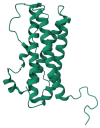Interactions Between Prolactin, Intracellular Signaling, and Possible Implications in the Contractility and Pathophysiology of Asthma
- PMID: 40806464
- PMCID: PMC12347873
- DOI: 10.3390/ijms26157332
Interactions Between Prolactin, Intracellular Signaling, and Possible Implications in the Contractility and Pathophysiology of Asthma
Abstract
Prolactin (PRL) is a hormone primarily associated with lactation, but it plays various roles in both men and women. PRL belongs to the family of peptide hormones, including placental lactogen and growth hormone. Interestingly, PRL is a pleiotropic hormone affecting several physiological and pathological conditions, including fertility. Moreover, several pathophysiological roles have been associated with this hormone, including those of the immune system, autoimmune disorders, asthma, and ageing. Additionally, PRL receptors are ubiquitously expressed in tissues, including the mammary gland, gonads, liver, kidney, adrenal gland, brain, heart, lungs, pituitary gland, uterus, skeletal muscle, skin blood cells, and immune system. Therefore, in the present paper, we cover the potential role that PRL may play in asthma by promoting inflammation and modulating immune responses. The detection of its receptor in lung tissue suggests a direct role in airway smooth muscle contractility through activation of signaling pathways such as JAK2-STAT5, MAPK/ERK1/2, and PI3K/Akt, as well as influencing ionic currents that regulate cell contraction, proliferation, and survival. In this sense, this review aims to explore the potential involvement of PRL in asthma pathophysiology by examining its interactions with intracellular signaling pathways and its possible impact on airway smooth muscle contractility and immune modulation.
Keywords: PRL; asthma; contraction; hormonal regulation; prolactin.
Conflict of interest statement
The authors declare no conflicts of interest.
Figures




Similar articles
-
Prescription of Controlled Substances: Benefits and Risks.2025 Jul 6. In: StatPearls [Internet]. Treasure Island (FL): StatPearls Publishing; 2025 Jan–. 2025 Jul 6. In: StatPearls [Internet]. Treasure Island (FL): StatPearls Publishing; 2025 Jan–. PMID: 30726003 Free Books & Documents.
-
Relationship between Pituitary Gland and Stem Cell in the Aspect of Hormone Production and Disease Prevention: A Narrative Review.Endocr Metab Immune Disord Drug Targets. 2025;25(7):509-526. doi: 10.2174/0118715303314551241031093717. Endocr Metab Immune Disord Drug Targets. 2025. PMID: 39812047 Review.
-
Short-Term Memory Impairment.2024 Jun 8. In: StatPearls [Internet]. Treasure Island (FL): StatPearls Publishing; 2025 Jan–. 2024 Jun 8. In: StatPearls [Internet]. Treasure Island (FL): StatPearls Publishing; 2025 Jan–. PMID: 31424720 Free Books & Documents.
-
T-bet expressing Tr1 cells driven by dietary signals dominate the small intestinal immune landscape.bioRxiv [Preprint]. 2025 Jul 4:2025.06.30.662190. doi: 10.1101/2025.06.30.662190. bioRxiv. 2025. PMID: 40747421 Free PMC article. Preprint.
-
Uncommon Non-MS Demyelinating Disorders of the Central Nervous System.Curr Neurol Neurosci Rep. 2025 Jul 1;25(1):45. doi: 10.1007/s11910-025-01432-8. Curr Neurol Neurosci Rep. 2025. PMID: 40591029 Review.
References
-
- GINA . Global Strategy for Asthma Management and Prevention. GINA; Singapore: 2024.
Publication types
Grants and funding
LinkOut - more resources
Full Text Sources
Miscellaneous

